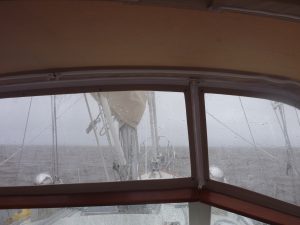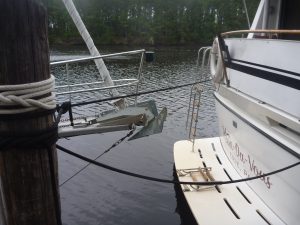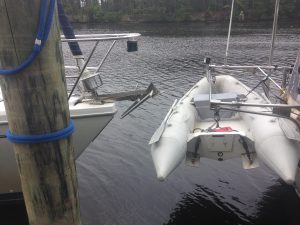5 & 6 May 2016 – Coinjock, NC – Great Bridge, Virginia
Today was probably the most miserable day we have had on this trip.
We woke up to FOG and very poor visibility, even worse than yesterday.
It was downright cold, with the temperature not forecast to get to 60F/15C. We layered up as best we could with 4 or 5 layers of clothes on and got ready to get underway.
We carefully pulled away from the dock and as we pushed away from the dock, and headed up the river, the fog rolled in thicker and thicker resulting in even lower visibility. Today may be a long day!
 As we began to make our way across Currituck Sound, the wind picked up causing the water to get even choppier and we took water over the bow several times, with it splashing all the way onto the dodger/windshield. We were very thankful for the full enclosure because if it wasn’t for that we would have gotten very wet (and even colder) from the splashing water.
As we began to make our way across Currituck Sound, the wind picked up causing the water to get even choppier and we took water over the bow several times, with it splashing all the way onto the dodger/windshield. We were very thankful for the full enclosure because if it wasn’t for that we would have gotten very wet (and even colder) from the splashing water.
The fog slowly lifted but the wind did not for quite a while. Once we were across the sound a few hours later, we had to traverse up a river/channel that was riddled with tree stumps and debris, always having to keep a look out for floating (and non floating) logs. Not a very relaxing day on the water.
Along the way we were passed by two HUGE tugs and barges. One was carrying scrap metal, and the other was pushing 2 old steel commercial boats side by side headed for scrap it appeared. Of course these two passed us on a curvy narrow part of the river where we didn’t have much extra room to maneuver.
The third tug we passed was right after a bridge and a blind corner. We knew there were two sailboats behind us and we tried to warn them on the radio of the tug’s approach to the bridge, but to no avail. We later heard the tug on the radio telling the sailboats they had to change direction to let him pass. It didn’t sound like any drama resulted, but it may have been better for all if the sailboats had responded and were warned beforehand.
There were also a few bridge openings we had to contend with. One of the bridges had been hit by a tug and barge a month or so ago, and now only the northern half of the bridge is able to open for boats to pass. So a bit of extra careful steering was necessary with the current and wind pushing us around through the more narrow opening.
When we finally were approaching our marina for the night in Great Bridge, Virginia, we radioed the dock master to say we had just cleared the bridge and asked for directions to the fuel dock and pump out.
He told us to “pull up to the red pilings after we passed the large sign”. We saw the sign but no red pilings. Confused, we asked again. He said the same thing. Still confused as we were now at the marina passing the dock, a third enquiry of “which end of the marina is your fuel dock” with the answer being the North. It was then I noticed the Great Bridge Bridge (a drawbridge) ahead, and said “Ohhhhh THAT bridge”. The dock master finally realized he thought we were a different sailboat heading south and giving us incorrect directions and thus the confusion between us.
With that sorted we made our way past the face dock, where we didn’t see any real open space for our boat which made us wonder where/if we were going to get a slip for the night. We’ll deal with that quandary after we fuel up and pump out.
Dock lines were rigged for a port side tie up and we pulled into the fuel dock without incident and filled the diesel. We had also asked for a pump out of the holding tank (human sewage from the toilet). But, the dockhand said, “nope”, their tank was full because they have had so many boats today. Ugh! As we only use our onboard head and when underway (usually walking to the marina’s facilities during the day) we should be good for another day – so no real drama just a bit more frustration.
The dockhand then said there were actually two spaces still available on the face dock we had just passed – one had 48’ and one had 50’ of space between the other boats. He looked at our boat and said how long IS your boat? Our boat is a 37’ boat, but when you add the bowsprit and dinghy davits it is 42’ per the specs. But the reality is that with the dinghy ON the davits, and anchors hanging off the bowsprit we were about to learn the hard way that we are at least 48’!
Due to the wind we would go back down the river and approach from the North which would require a starboard tie-up. This means Christina must hurriedly move the dock lines and fenders from one side of the boat to the other as Bob makes our way to the slip.
As we approached the 48’ space the dockhand was waiting for us. I was near the bow with a dock line in hand to throw to him and of course the wind chooses this time to pick up again.
Just to give you an idea of what we were about to attempt: Imagine parallel parking a large SUV/Hummer/LandCruiser into a space that looks like it could possibly accommodate a compact car.
Christina looked at the available space and told the dockhand she didn’t think we would fit. He didn’t say anything and just stood there waiting for the line. She threw him the spring line, which is tied to the midship cleat, so he would have better control of our boat as he pulled us onto the dock. It was then that we noticed we were getting too close to the boat we needed to be in front of. Rushing back as far aft as possible, Christina fended off the other boat’s pulpit so we wouldn’t collide.
Because of the design of our boat, there is no deck to walk on for the last 1/4 length of the boat, and because of the enclosure we can’t reach out from the cockpit to fend off in this section. So Christina found herself doing the unsafe thing of standing on the edge (toerail) as far back as possible reaching over the life line and pushing off their boat. Any slip and she would find herself in the water.
As we continued forward she could no longer reach the offending pulpit or anchor on the other boat and we could tell their anchor was going to connect with something on our boat. Sure enough, our dinghy outboard scraped by the anchor and it finally hooked to our dinghy davit.
Bob stopped the forward movement, the dock hand gave us some slack and Bob was able to un-hook us and began to ease our boat into the slip again. Christina rushed to the front of the boat to throw the bow line and watch as our anchor on our pulpit came perilously close to the boat ahead.

Once we were tied up, our anchor was literally hanging over the transom of the boat ahead of us, and there were just inches between the anchor of the boat behind and our dinghy. AMAZING!

Bob really did a superb job easing us into the slip with no damage to dock or boats.
He later revealed that because of the wind pushing us he actually had no control of steering in idle forward (think of the forward momentum of a car when it is in gear but no foot on the gas pedal) and so had to give it more throttle than he wanted and then pull back so we didn’t come crushing onto the dock.
We really didn’t know how we were going to get out of the slip when it was time to leave tomorrow, and hoped our neighbors ahead of us and behind us would leave before we did. But we’ll worry about that tomorrow. For now, it is time to pour a cocktail and breathe a sigh of relief that this day is done.
Bob’s brother lives in Virginia Beach and he came to the marina to go out to dinner with us, and we had a nice family evening out.
It was also this day that Bob shared his observation that the battery gauge had been reading less volts than usual. The day prior we had heard the inverter start running as soon as we turned the shore power on which was unusual. When he started the engine after fueling up today the engine was harder to start than usual. These three things are telling us that something is different on the boat. Although everything seems to be working we know that when something starts acting differently on the boat, it is the boat’s way of trying to warn you…and it is wise to not ignore the warning signs.
Not knowing exactly what was happening, we came to the conclusion that something was different with either the alternator, the voltage regulator or something else. But because everything was ultimately working, we thought there was no immediate danger and we would continue to monitor and troubleshoot as we go.